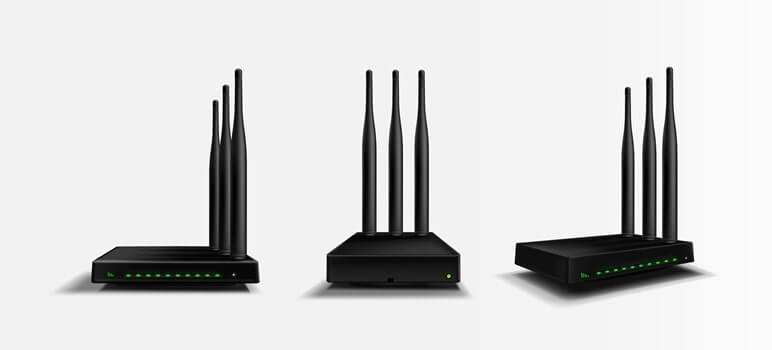In today’s connected world, where we rely on wireless devices and smart technologies more than ever, the question often arises: Can you use more than one router in your home? While the answer may seem straightforward, it comes with a few nuances. In this article, we’ll delve into the pros and cons of having multiple WiFi routers at home to help you make an informed decision.

Can You Use Multiple WiFi Routers at Home?
The short answer is yes, you can use multiple routers in your home.
However, whether it’s a good idea depends on your specific needs and circumstances.
For most households, a single router is sufficient.
But if you live in a large home or experience dead spots, there are ways to extend your WiFi coverage effectively.
Read also: 10 Effective Ways to Strengthen Your Router’s Performance
Pros of Using Multiple Wi-Fi Routers
1. Extended Coverage
One of the key benefits of using more than one router is that it helps make your WiFi signal cover a larger area in your home.
Imagine you have a big house, and sometimes, when you’re in certain rooms, the internet connection isn’t as strong as you’d like it to be.
This is where having a second router can be really helpful.
It acts like a booster, making sure you can use the internet smoothly even in those far-off corners of your home where the WiFi used to be weak or non-existent.
It’s like having a reliable internet buddy that helps your devices stay connected wherever you are inside your house.
Read also: How to Boost the Power of Your Home Wi-Fi
2. Support for More Devices
When you have multiple routers in your home, it’s like having extra doors to the internet.
Each router has its own special entryway, called Ethernet ports.
Think of these as plugs for your devices to connect to the internet.
So, having a second router means more of your gadgets can plug in directly and get super-fast internet.
This can make your internet feel really speedy, especially when lots of people are using it at the same time.
It’s like having more lanes on a highway, so there’s less traffic and everything moves faster.
3. Even Device Distribution
Picture your internet connection like a pizza that everyone in your house wants a slice of.
When you have more than one router, it’s like having someone in charge of making sure everyone gets a fair share of the pizza.
So, if your family or roommates are using lots of phones, tablets, or laptops, each router can make sure that all these devices get an equal amount of internet.
This keeps everything running smoothly and avoids one person or device hogging all the pizza (or in this case, the internet), making sure everyone enjoys a consistent and stable connection.
Pro Tip: Upon receiving a router from your internet provider, you’ll typically find it set with a default password, which you should change immediately. We’ll guide you through the necessary steps to reset your WiFi password.
Cons of Using Multiple WiFi Routers
1. Signal Interference
Imagine your WiFi signal as a group of friends talking in a crowded room.
Now, if you introduce more friends who start talking loudly at the same time, it can become chaotic.
That’s what happens when you use multiple WiFi routers.
They all talk on the same ‘frequency,’ like a channel on a walkie-talkie.
When these routers ‘talk’ at the same time, it can cause confusion.
Your devices might have trouble understanding which router they should listen to, a bit like everyone trying to understand multiple conversations at once.
This can slow down your internet and make it less reliable.
So, while having extra routers can be helpful in some ways, it’s essential to set them up correctly to avoid this kind of ‘noise’ in your WiFi world.
2. Connection Loss Between Routers
Think of your WiFi routers as friendly guides in a big building.
When you move from one room to another, you might briefly lose sight of one guide before the other picks up where they left off.
During this transition, it’s like you’re temporarily closing your eyes before opening them again.
This is similar to what happens when you move around your house with multiple routers.
Your device might lose its connection to one router for a moment before connecting to another.
It’s a bit like switching from one tour guide to another as you explore different rooms.
While it’s usually a quick process, it can be annoying if you’re in the middle of something online, like watching a video or playing a game.
So, although multiple routers can be useful for coverage, this ‘handoff’ between routers can sometimes be a hiccup in your online experience.
3. Complexity
Think of having multiple routers like having different remote controls for various devices in your home.
Each remote does something different, and sometimes you need to switch between them.
It’s a bit like using one remote for the TV and another for the sound system.
In the same way, with multiple routers, you might need to do different things to keep them working smoothly.
For example, you might have to log in to one router when you’re in one part of the house and then switch to another router’s settings when you move to a different room.
This can be a bit like juggling multiple remotes and can take some time.
It’s not always as simple as using just one remote for everything, which can make things feel a bit complicated.
So, while having multiple routers can extend your WiFi, it can also add some extra steps to manage them effectively.
Better Alternatives to Multiple WiFi Routers
Instead of using multiple routers, consider these alternatives for improving your WiFi coverage:
1. Mesh WiFi System
Think of a Mesh WiFi system as a team of helpers ensuring you have internet wherever you go in your home.
It’s like having a group of friends passing along a message in a game of telephone.

Instead of relying on just one router, a Mesh WiFi system uses several access points spread around your house.
These access points work together like a team, making sure there are no ‘dead spots’ where your WiFi doesn’t work well.
It’s as if they create a web of connectivity, so your devices can smoothly switch between them without you even noticing.
This way, you get strong and seamless internet coverage all over your home, much like having reliable friends passing the message along to ensure it never gets lost.
It’s a convenient and hassle-free way to enjoy WiFi everywhere in your house.
2. WiFi Extenders
Imagine your WiFi signal as a campfire’s warmth on a chilly night.
It’s cozy when you’re close to the fire, but as you move farther away, you start feeling the cold.
WiFi extenders are like special lanterns you can place between the campfire and where you start feeling the chill.
These lanterns catch the warmth of the campfire and then shine it further into the darkness, making sure you stay warm even when you’re far from the fire.
In the same way, WiFi extenders catch your existing WiFi signal and then spread it to areas where it was weaker or non-existent.
They help fill in those ‘cold spots’ in your WiFi coverage, ensuring that your internet connection reaches every corner of your home, just like the warmth from the campfire reaches every camper.
It’s a handy solution for staying connected everywhere in your house.
3. Ethernet Cabling
Think of Ethernet cables as the trusty roads for your internet traffic.
While WiFi is like the air, convenient but sometimes with a few bumps, Ethernet cables are like well-paved highways. They provide a smooth and direct path for your internet signals.
When you use Ethernet cables, you’re plugging your device directly into the internet source, much like plugging a lamp into an electrical outlet. It’s a straightforward and reliable connection.
These cables can be handy when you’ve tried everything else to get a fast and stable internet connection, and you just need it to work reliably.
So, even if you’re using WiFi for most of your devices, you can still use Ethernet cables to extend your network’s reach.
It’s like having a superhighway for your internet data, ensuring a smooth and speedy connection, especially when you need it the most.
Conclusion
While using multiple routers can be a solution for some, it’s not without its drawbacks, including signal interference and connectivity issues. For most households, exploring alternatives like Mesh WiFi systems, extenders, or Ethernet cabling may provide a better and more reliable solution to improve WiFi coverage. Ultimately, the choice depends on your specific needs and the layout of your home. Consulting with a professional WiFi installation team can help you determine the best solution for your situation.

